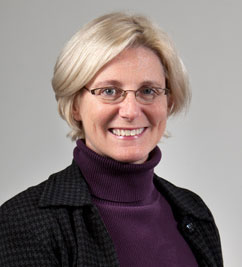Home Cultures Shape Math Instruction
July 29, 2013

Anita Wager
You might think that students will achieve academically as long as their teachers use effective standards-based teaching practices. Yet, students often lag behind in math because they don’t see a connection between the mathematics they use in school and the mathematics they experience out of school.
Effective teachers recognize that students bring different kinds of mathematical strengths into the classroom that can be used to raise students’ math competencies in formal schooling. Anita Wager, a UW–Madison professor in Curriculum and Instruction, points out that students learn mathematics more effectively when it connects to their lives outside of school.
Wager says educators must learn their students’ cultural and community mathematical practices and then connect these to what happens in school. She stresses that the way teachers translate or mathematize out-of-school practices needs to be meaningful. Otherwise classrooms will trivialize the mathematical ideas inherent in student’s home practices.
To find out how teachers respond to this need to identify meaningful ways to incorporate out-of-school practices in mathematics classrooms, Wager studied a professional development seminar for elementary teachers. The study sought to determine (a) how teachers incorporated students’ out-of-school experiences in the mathematics classroom, and (b) the benefits and constraints of the various methods.
The semester-long professional development seminar focused on culturally relevant pedagogy. The seminar participants taught in three elementary schools that served diverse student bodies. Across the schools, 40% to 74% of students were from Native American, African American, Latino/a, and Hmong families. Of the students, 27% to 70% were eligible for free or reduced-price lunch.
During the ten three-hour seminar sessions, the participants read about the importance of children’s out-of-school mathematical practices and possibilities for culturally relevant pedagogy in the classroom. They designed surveys for students 8 to 10 years old to discover the types of mathematical activities in which students and their families participated. They then discussed how to build on these student practices.
Teachers then compared results of their own classroom surveys to those of their school and the other schools to identify individual, classroom, and school differences. This activity prompted teachers to further explore their own students’ home, community, and cultural mathematical practices, as well as other ways to learn about their students. Teachers later taught, then reflected on, the lesson ideas they developed.
Wager’s study identified four practices that these teachers tried in their classrooms to draw from students’ cultural and out-of-school experiences.
Using context
The most common way the teachers linked school mathematics to students’ lives was to use student experience as the context for word problems and lessons. Two teachers, for example, were aware of several students’ interest in soccer. These two teachers created math word problems about measuring the area of a soccer field.
While it’s good that they attempted to connect real-world experience to the classroom, Wager notes that this example probably has limited effectiveness. Although several children may play or watch soccer, the mathematics they engage with relative to soccer likely does not include measuring the soccer field.
Mathematical practices linked to school
Some teachers identified an out-of-school activity that required mathematics and then matched it to a math activity in school. For example, one teacher knew of a Hmong student’s practice of regularly helping her grandmother make “story cloths.” Seizing upon what she viewed as a cultural practice, the teacher attempted to relate that activity to school mathematics by discussing measurements that might be required to make story cloths.
Wager says it was unclear whether the strategies the child used for measuring story cloths differed from strategies the child learned in school. To effectively link this practice to school math, the teacher would need to learn the unique ways the child and her grandmother used measurement while making the story cloths.
Embedded mathematical practices
Embedded practices refer to situations in which a particular context drives the mathematics. In these situations, students develop informal strategies to accomplish a real-world task. These often differ substantially from the mathematical strategies typically taught in school. To identify these informal strategies, teachers need to observe them or ask the students to replicate the practice and explain their strategies. For example, one teacher asked students how they use money when shopping with their families. She found that students who shopped with their families were able to quickly solve problems regarding currency and used powerful strategies.
Wager says this was the most authentic integration of out-of-school practice. It builds on informal strategies students use, and it explicitly addresses equity issues about the importance of connecting to practice.
Teacher-initiated situated settings
Some teachers developed rich lesson units that drew from an experience common to all students. Teachers first identified the mathematics content embedded in the shared activity and then linked it to school mathematics. Wager says this teaching practice can vary greatly in terms of complexity and time required to develop activities. A basic approach would be to take ideas from a shared reading to create word problems. As a more complex example, one fifth-grade teacher designed a unit she called the “International Bazaar.” Students explored several world currencies. They then worked in groups to manage “stores.” Each group had an imaginary currency and exchange rates that fluctuated daily. The activities of shopping and store management over a 3-week period covered geometry, fractions, decimals, percentage, and ratio.
Conclusion
During this research, Wager realized that teachers need significant support to be able to identify and build on students’ embedded mathematics practices. As noted in the examples above, the teachers generally made an effort to build on the informal strategies students use, but did not always do so in an effective way. With help, however, teachers can transform an activity that students find artificial into one that uses the students’ own informal math strategies to create richer, more meaningful experiences with mathematics. Wager has extended this work to her current project in which she and colleagues are facilitating professional development with pre-K teachers.


